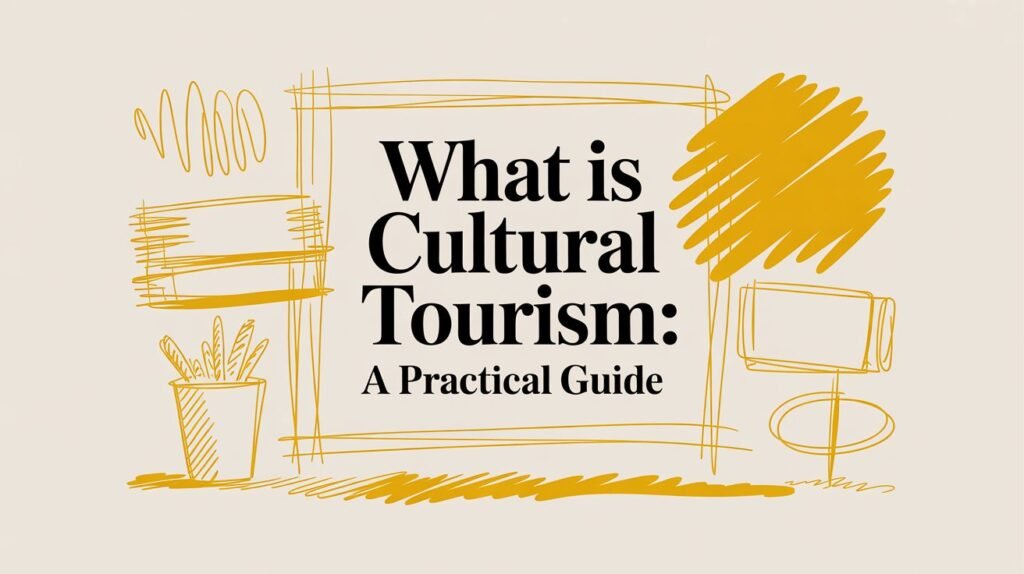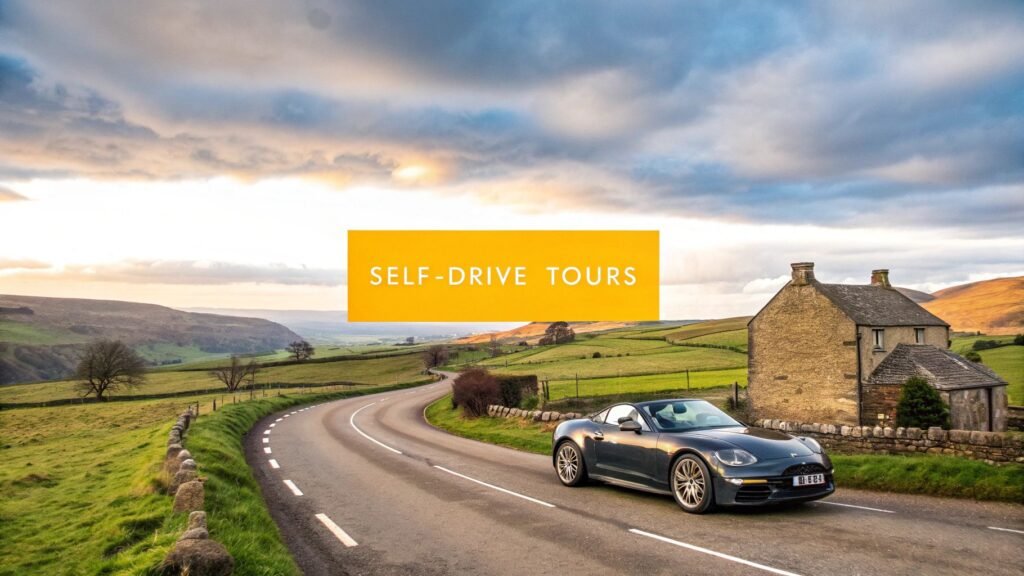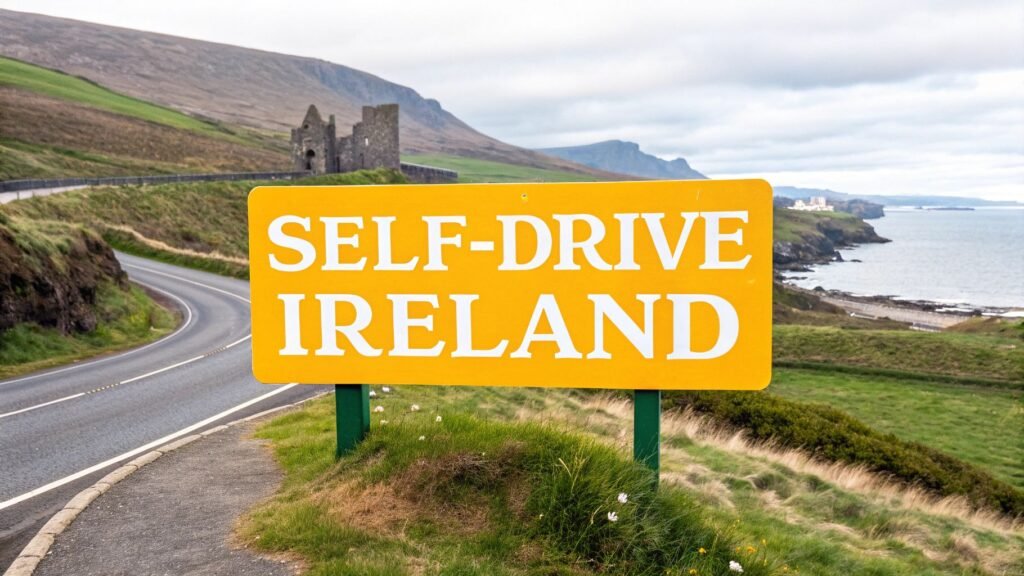When you hear the term 'cultural tourism', what comes to mind? For many, it's a whirlwind tour of museums and ancient ruins. But it's so much more than that. It’s about diving headfirst into the living, breathing heart of a destination—its art, its people, its traditions, and its daily rhythms.
Think of it less as being a spectator and more like being an invited guest, ready to experience a place from the inside out.
Defining Cultural Tourism Beyond The Obvious
To really get what cultural tourism is all about, let's swap the idea of a "sightseeing trip" for an "immersive journey".
Picture this: you’re visiting a village in the Scottish Highlands. A typical tourist might snap a photo of a dramatic old castle and call it a day. But a cultural traveller? They might stick around for the local Highland games, spend an afternoon with an artisan learning how to weave tartan, and end the day sharing a pint at the pub while listening to a live folk band. See the difference?
This approach turns travel from a passive checklist into an active, meaningful exchange. You’re connecting with the soul of a place—the stories etched into ancient stones, the distinct flavour of a family recipe, and the unique energy of a bustling local market. It’s about valuing the living culture as much as the historical monuments.
To get a quick sense of how these two travel styles differ, here’s a simple breakdown:
Cultural Tourism At A Glance
| Aspect | Cultural Tourism (The Immersive Journey) | General Tourism (The Sightseeing Trip) |
|---|---|---|
| Primary Goal | To understand and connect with the local culture, heritage, and people. | To see famous landmarks and attractions. |
| Pace | Slower, more deliberate, allowing for spontaneous discoveries. | Often faster-paced, following a set itinerary or checklist. |
| Interaction | High level of engagement with local communities, artisans, and traditions. | Minimal interaction, often as a passive observer. |
| Souvenirs | Focus on locally made crafts, memories, and new perspectives. | Often standard souvenirs and photographs. |
| Impact | Directly supports local economies and encourages cultural preservation. | Economic benefits are often concentrated in larger, tourist-focused businesses. |
This table shows it clearly: cultural tourism is about depth, not just distance.
From Sightseeing to Connecting
The real shift is in your mindset. Sightseeing is often driven by a to-do list, whereas cultural tourism is fuelled by genuine curiosity. It's about wanting to understand the 'why' behind what you're seeing. A big part of this is grasping what constitutes historical significance, as it provides the context that turns a pile of old rocks into a story of human triumph and struggle.
This authentic way of travelling isn’t just rewarding for you; it creates a positive, sustainable cycle for the places you visit. When travellers seek out and pay for genuine local experiences, that money goes right back into the community, helping to preserve the very culture they came to see.
The UK's tourism economy is a powerful example of this. With a staggering 41.2 million visits in a recent year, tourism now makes up about 10% of the British GDP. A huge chunk of that comes from international visitors drawn by the UK's rich cultural tapestry, who spent an estimated £32.5 billion. Holidays made up 63% of those trips, proving that cultural exploration is a massive economic driver.
Cultural tourism is the bridge between seeing a place and understanding its people. It’s about collecting memories and perspectives, not just souvenirs and photographs.
Ultimately, this way of travelling builds a profound appreciation for the world's diversity. It sends you home with a richer perspective and empowers local communities to keep their unique heritage alive for generations to come. If you're keen to find a trip that prioritises this kind of connection, exploring different BTOURS travel styles is a great place to start.
Exploring The Different Types Of Cultural Travel
Cultural tourism isn’t a one-size-fits-all experience. Far from it. It's a rich spectrum of travel styles, each offering a unique way to connect with the very soul of a destination. Figuring out which type speaks to you is the key to transforming a simple holiday into a genuine journey of discovery.
Think of it like exploring different genres of music. You might love the raw energy of rock, the intricate patterns of classical music, or the storytelling of folk. In the same way, cultural travel has its own distinct categories, from stepping back in time to creating something new with your own two hands.
This infographic gives a great visual breakdown of what we're talking about, showing how it’s all about balancing sightseeing with a real connection.
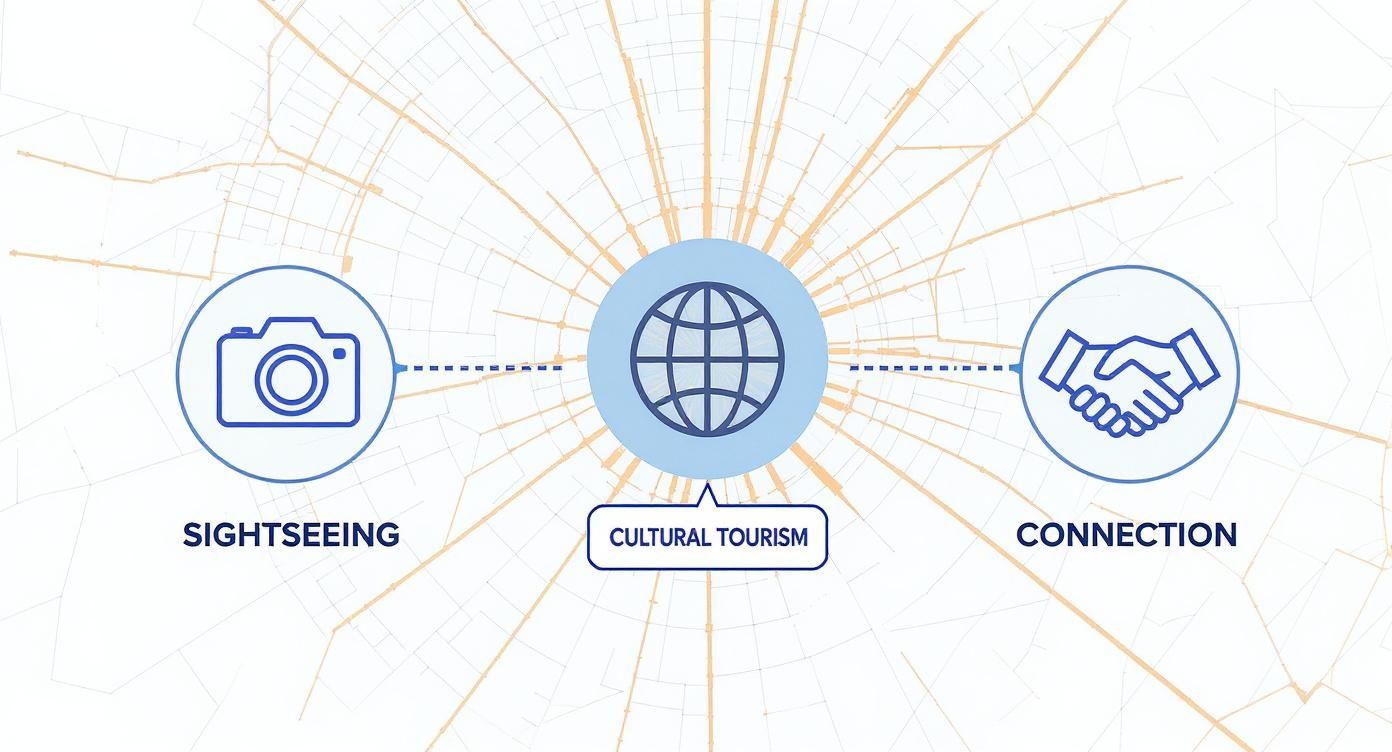
As you can see, the core idea is to move beyond just looking at things and start actively participating and understanding. So, let’s dive into what that actually looks like in practice.
Heritage And Historical Tourism
This is what most people picture when they think of cultural travel. It's the classic stuff: visiting places that tell the story of a nation or a community through its buildings, artefacts, and historical landscapes. It’s about quite literally walking through history.
Instead of just snapping a photo of a castle, a heritage tourist wants to understand its role in shaping the local identity. This kind of travel is incredibly popular, and it’s a huge part of the tourism economy.
In fact, the UK's special interest tourism market, which covers cultural and heritage travel, is set to grow from USD 367.3 million to USD 918.2 million over the next decade. That 9.6% annual growth rate shows just how much people are craving these authentic experiences.
- Real-World Example: Imagine a self-drive tour through Northumberland. You could explore Hadrian's Wall, visit the ancient Holy Island of Lindisfarne, and wander the magnificent halls of Alnwick Castle. Every stop offers a direct link to Roman, early Christian, and medieval English history.
Creative And Arts Tourism
Creative tourism shifts the focus from observation to participation. It’s for travellers who don’t just want to see art—they want to make it. This hands-on approach involves learning a skill directly from local artisans, creating a deep and personal connection to a region's creative pulse.
This could mean anything from taking a pottery class in a small village to joining a cooking workshop or learning a traditional dance. It’s an active, immersive way to engage with a culture’s living, breathing artistic side.
Creative tourism is about unlocking your own creativity while connecting with the artistic soul of a place. It’s the difference between admiring a painting and learning how to mix the colours yourself.
Urban Cultural Exploration
Cities are absolute powerhouses of culture, both old and new, offering a dense and diverse range of experiences. Urban cultural tourism is all about diving into the unique character of a city, well beyond the main tourist traps. It means exploring distinct neighbourhoods, popping into independent galleries, discovering local music venues, and savouring the culinary scene like a local.
This kind of travel is perfect for anyone who thrives on the energy of city life. For some great ideas to get you started, have a look at our guide to unforgettable BTOURS city breaks.
- Real-World Example: Picture a weekend in Manchester's Northern Quarter. You could spend your time exploring its vibrant street art, browsing independent record shops, visiting the Manchester Craft and Design Centre, and catching a gig at a legendary music venue. You're soaking in the city’s industrial past and creative present all at once.
Rural And Indigenous Tourism
Away from the buzz of the cities, rural cultural tourism offers a chance to connect with the traditions, landscapes, and lifestyles of the countryside. This might involve staying on a working farm, joining in with a local harvest festival, or learning about traditional land management from the people who know it best.
This often overlaps with indigenous tourism, which focuses on respectfully experiencing the cultures of First Peoples. This could mean taking guided walks to learn about native plants, listening to ancient stories passed down through generations, or visiting cultural centres that preserve and share indigenous heritage. This kind of travel provides a powerful connection to the land and its oldest custodians, offering a perspective you simply can't find anywhere else.
Why This Form Of Travel Matters More Than Ever
Cultural tourism is so much more than a lovely way to spend a holiday. It’s a powerful force for good in a world that feels more connected, yet more divided, than ever. Its benefits ripple outwards, enriching you as a traveller while also strengthening the communities you visit. It's this two-way street that makes it such a meaningful and sustainable way to see the world.
For the traveller, the rewards are personal and profound. It’s about getting past the postcard view and gaining a real feel for different ways of life. This kind of travel chips away at our assumptions, builds empathy, and helps us develop a more thoughtful, nuanced perspective of the world.
Instead of just coming home with a phone full of photos, you return with new insights, skills, and memories that become part of who you are. These are the kinds of souvenirs that actually last a lifetime.
The Personal Growth of the Cultural Traveller
Setting off on a cultural journey is really an investment in yourself. It nudges you out of your comfort zone, sparking curiosity and encouraging an open mind. The benefits are felt both in the moment and for years to come.
- A Deeper Understanding of the World: Nothing beats first-hand experience. Engaging directly with different traditions and viewpoints offers a real-world education that no book or documentary can match. You start to truly appreciate the incredible complexity and beauty of human diversity.
- Meaningful, Lasting Memories: The memories you make aren't just of places, but of people and shared moments. Learning to cook a local dish from a new friend or listening to a village elder’s stories forges a much stronger emotional connection than simply snapping a picture of a monument.
- A Better Sense of Self: By seeing how other cultures work, we often gain a clearer perspective on our own. It makes you think about your own values, habits, and assumptions, leading to some surprising and significant personal growth.
Empowering Host Communities
Beyond the personal benefits, cultural tourism offers something vital to the places we visit. When it's done thoughtfully, it becomes a powerful tool for preservation, empowerment, and sustainable income. It gives communities a real reason to protect and celebrate what makes them unique.
This isn’t just a nice idea; it’s a reality for communities all over the globe. Picture a small Welsh village known for its traditional weaving. As curious travellers show an interest, demand for authentic, locally made textiles grows. This not only provides an income for skilled artisans but also inspires the younger generation to learn the craft, making sure a priceless piece of heritage doesn’t fade away.
Cultural tourism provides a sustainable economic lifeline that celebrates, rather than commercialises, local identity. It empowers communities to be the proud custodians of their own stories and traditions.
The economic impact is huge. In the UK alone, over four million people work in the tourism industry, with cultural and heritage sites being massive draws. And it’s not just about London; regional hubs like Edinburgh and Manchester pull in 2.3 million and 1.7 million visitors a year, respectively. This shows how cultural tourism spreads the economic benefits right across the country, supporting local businesses and fostering a wider appreciation for Britain’s rich, diverse heritage. If you want to dig deeper, you can explore more UK tourism statistics on travelperk.com.
A Cycle of Mutual Respect and Preservation
When you boil it down, this way of travelling creates a beautiful, self-sustaining cycle. Travellers seek out genuine experiences, and by doing so, they provide the economic support that allows communities to preserve their unique cultural treasures. This, in turn, makes sure those authentic experiences are still there for future travellers—and for the local community—to enjoy.
It’s a true partnership, built on mutual respect and a shared appreciation for the world's incredible cultural tapestry. When you choose to travel this way, you're not just a tourist. You're an active participant in the global effort to protect and celebrate our shared human story.
Planning Your Own Cultural Self-Drive Adventure
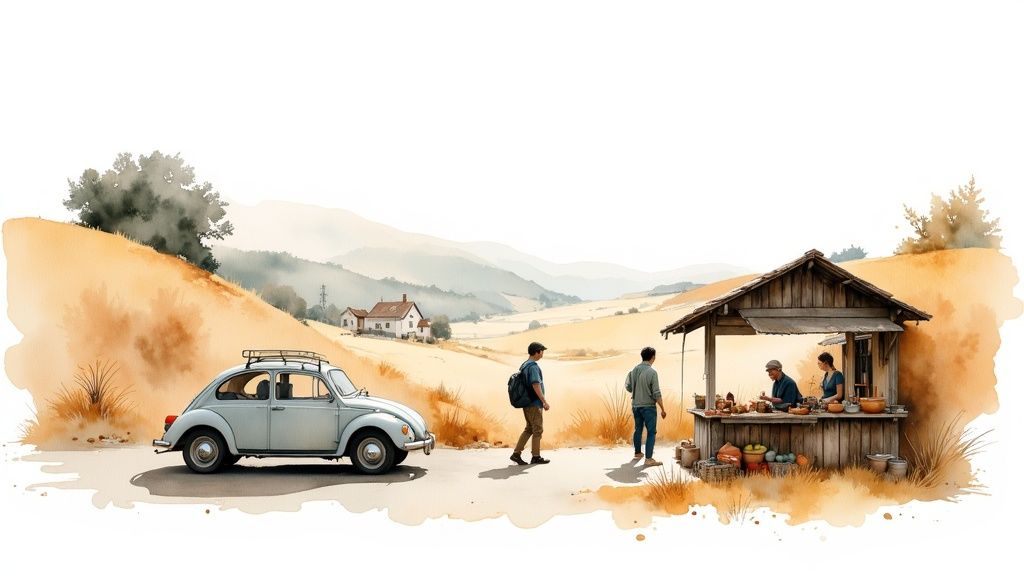
Now that we've explored what cultural tourism is all about, it's time for the fun part: putting that knowledge into practice. Nothing offers the freedom to create a truly personal journey quite like a self-drive tour. It gives you the power to linger in that captivating village you just stumbled upon or to follow an intriguing country lane just to see where it leads.
This approach puts you firmly in the driver's seat—both literally and figuratively. Your trip transforms from a checklist of places to see into an active exploration, where every turn in the road holds the promise of a new discovery. The secret isn't in rigid planning, but in creating a smart framework that leaves plenty of room for spontaneity.
Laying The Groundwork For Discovery
First things first: think beyond the big-name attractions. Of course, iconic landmarks are often incredible starting points, but the real heart of a place is usually found just off the beaten path. This calls for a bit of creative research before you even think about packing your bags.
Instead of just Googling "top sights," try digging a little deeper. Look up local event calendars, find schedules for farmers' markets, or read blogs written by people who actually live there. These are the resources that offer a genuine glimpse into the daily rhythm of a place, guiding you toward experiences most tourists completely miss.
What are you passionate about? Is it historic pubs with centuries of stories soaked into their walls? Independent bookshops tucked away in old university towns? Or maybe it's hunting down regional culinary specialities? Building your journey around these interests is the surest way to have authentic and unforgettable encounters.
Crafting A Flexible Itinerary
A minute-by-minute schedule is the enemy of cultural discovery. The whole point of a self-drive adventure is the freedom to adapt. Think of your itinerary as a friendly guide, not a strict script, with plenty of blank space for the unexpected.
Here are a few tips for striking that perfect balance:
- Anchor Your Days: Pick one or two "must-do" activities or places for each day, but leave the hours in between open. This gives your day a sense of direction without feeling rushed.
- Embrace The Detour: See a sign for a local craft fair or a quirky little museum? Give yourself permission to follow it. These impromptu stops often become the most cherished memories of a trip.
- Travel Less, See More: It's tempting to cover huge distances every day, but resist the urge. Shorter drives mean more time on the ground to explore, chat with locals, and truly immerse yourself.
The goal of a cultural self-drive tour isn't just to get from Point A to Point B. It's to experience everything in between—the conversations, the landscapes, and the unexpected moments of connection.
This flexible philosophy is at the heart of what we do at BTOURS. Our expertly planned self-drive tours across the UK give you a curated route and hand-picked accommodations, providing a solid foundation while leaving you completely free to explore at your own pace.
Engaging Respectfully With Local Communities
At its best, cultural tourism is a two-way street built on mutual respect. As a visitor, your curiosity and engagement can have a wonderfully positive impact, but it’s crucial to approach every interaction with sensitivity and an open mind.
Always remember that you're a guest in someone's community. Simple gestures go a long way, like learning a few words in the local language (even just "hello" and "thank you") and being mindful of local customs.
Modern tools can also help you connect more deeply. For instance, understanding the use of QR codes in travel and tourism can be surprisingly handy, giving you instant access to information on historical sites, local walking tours, or cultural events right on your phone.
To help you get started, we've put together a simple checklist for planning a thoughtful and respectful trip.
Your Self-Drive Cultural Tour Planning Checklist
| Planning Stage | Key Action | Pro Tip |
|---|---|---|
| Research | Learn basic etiquette and cultural norms of your destination. | Look up local opening times; many smaller shops or pubs may close mid-afternoon. |
| Booking | Choose locally owned guesthouses, B&Bs, or independent hotels. | This ensures your money directly supports the local community. |
| On The Road | Shop at local markets and buy crafts directly from artisans. | Ask about the story behind an item to create a more meaningful connection. |
| Interaction | Always ask for permission before taking photos of people. | A smile and a simple gesture are universally understood. |
When you travel with this kind of awareness, you shift from being a mere observer to a welcome participant. This mindful approach doesn't just enrich your own experience; it helps ensure that cultural tourism remains a positive force, fostering preservation and mutual understanding for years to come.
Inspiring Cultural Journeys Across The UK
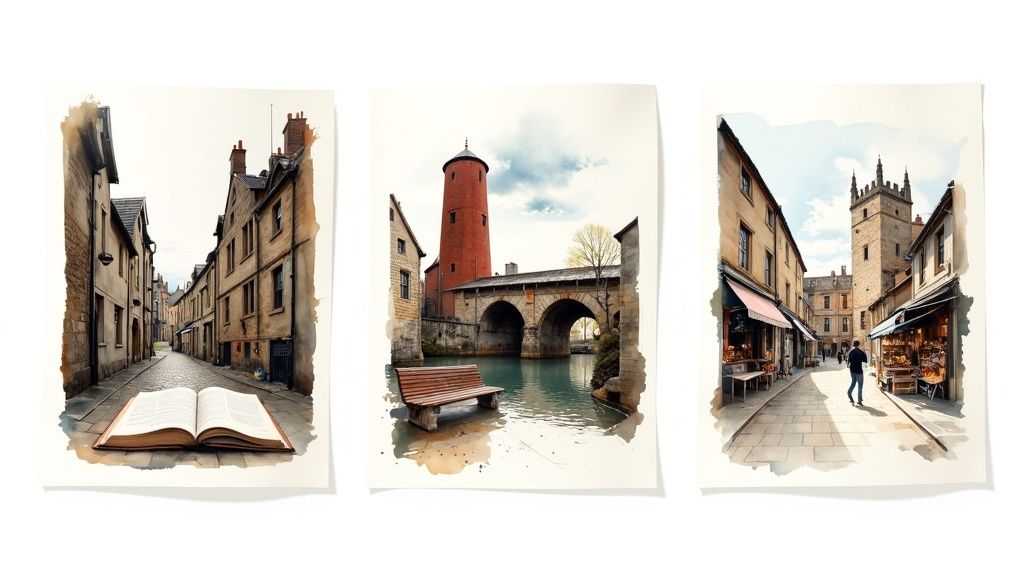
Talking about cultural tourism is one thing, but actually experiencing it is where the magic happens. To give you a real feel for it, let's step away from the definitions and look at a few journeys you can take yourself across the United Kingdom. Think of each one as a story waiting for you to step into, where history, art, and local life all come together.
These ideas are here to spark your imagination and show just how much variety is packed into this island. Whether you're pulled in by the poetic landscapes of Scotland, the industrial heart of Northern England, or the myth-soaked valleys of Wales, there's a cultural adventure out there with your name on it.
Scotland: A Literary Tour From City To Skye
For anyone who loves the written word, a trip through Scotland feels like walking right into the pages of your favourite book. Its brooding, dramatic landscapes have been firing up the imaginations of poets and novelists for centuries, making it the perfect backdrop for a literary road trip.
Your story starts in Edinburgh, a designated UNESCO City of Literature. Give yourself a day to just wander the same cobbled streets as Robert Louis Stevenson and Sir Walter Scott. You can pop into the Writers' Museum, hidden away in an alley off the Royal Mile, and soak up the creative spirit that still hums in the city’s old pubs and cosy cafés.
From there, point the car north towards the Highlands, tracing the very landscapes immortalised by Robert Burns. The drive itself becomes part of the experience, with every winding road and misty loch adding another chapter to your tale. Just imagine reading a verse from Burns while looking out over the exact hills he was describing—it's a powerful way to connect the words to the world.
A few must-see stops for your itinerary:
- The Elephant House: The famous Edinburgh café where a certain J.K. Rowling wrote early drafts of the Harry Potter books.
- Abbotsford House: Sir Walter Scott’s magnificent home, which feels like a time capsule of 19th-century literary life.
- The Isle of Skye: Its rugged, almost otherworldly beauty inspired countless myths and tales, providing the perfect, dramatic final act for your journey.
Northern England: The Industrial Heritage Trail
The story of Northern England is one of grit, ingenuity, and world-changing innovation. The Industrial Revolution wasn't just a moment in history; it was a cultural tidal wave that shaped the modern world, and its legacy is carved into the very DNA of cities like Manchester and Liverpool.
A self-drive tour along this heritage trail gives you a front-row seat to this transformative period. Kick things off in Manchester, the world’s very first industrial city. You can explore the Science and Industry Museum, brilliantly housed in the former Liverpool Road Station, and stand in awe of the colossal machines that once powered a nation.
From Manchester, it's just a short drive over to Liverpool. This city's soul is tied to its maritime past. Take a walk around the historic Albert Dock, visit the Maritime Museum to grasp the city's pivotal role in global trade, and then completely switch gears to explore its most famous cultural export: The Beatles. It’s this fantastic contrast between industrial might and creative rebellion that makes the region so compelling.
Exploring Northern England’s industrial past is to witness the birthplace of the modern age. It’s a journey that connects the clatter of 19th-century mills to the vibrant, creative pulse of its cities today.
Wales: A Journey Through Food And Folklore
Wales is a land where myths feel like they could be true and every hill and valley has a story to tell. A cultural tour here is an enchanting mix of ancient history and a surprisingly modern food scene. It’s a proper feast for the senses, where you can taste the history in a traditional Welsh cake and hear old legends whispered on the wind.
Start your adventure by exploring the formidable castles of North Wales, like Conwy and Caernarfon. These stone giants aren't just ruins; they're powerful symbols of Welsh identity and resilience. Standing on the battlements, you'll look out over the same landscapes that have been fought over and farmed for centuries.
As you meander south, let your stomach be your guide. Wales is in the middle of a food renaissance, with local producers and creative chefs putting a fresh spin on classic ingredients. Stop at farmers' markets to sample artisan cheeses and cured meats, and hunt down small, independent restaurants serving up lamb sourced from the surrounding hills.
This kind of trip is the perfect example of living culture. The folklore gives you the history, while the food offers a delicious taste of its vibrant present.
And if you’d rather let someone else do the driving, exploring the best of Britain by train is another fantastic way to soak in the country's diverse landscapes. These are just starting points, of course—designed to show how any holiday can be turned into a rich, personal quest for connection and understanding.
Common Questions About Cultural Tourism
Once you've got your head around the idea of cultural tourism, a few practical questions almost always come up during the planning stage. Sorting these out can be the difference between a good trip and a truly unforgettable one. This section is all about tackling those common queries, so you can head off on your adventure with confidence.
Think of this as the final once-over for your travel toolkit before you hit the road. We’ll look at the subtle differences between similar travel styles, touch on how to be a more thoughtful visitor, and show you that this way of travelling is for everyone, no matter the budget.
How Is Cultural Tourism Different From Historical Tourism?
That's a great question, and it's easy to see why people get them mixed up. They're like close cousins, sharing a lot of DNA, but their main focus is different.
Historical tourism is all about the past. It’s a deep dive into specific events and bygone eras—think visiting ancient ruins, walking through battlefields, or exploring museums dedicated to a particular period in time.
Cultural tourism, on the other hand, casts a much wider net. It absolutely includes history, but it also celebrates the living, breathing culture of a place. This means you might find yourself wandering through a contemporary art gallery, catching a local band at a festival, tasting your way through a food market, or simply people-watching from a café.
Here’s a simple way to think about it: Visiting the Tower of London to learn about its history is a classic historical tourism activity. But pairing that with an evening at a Camden music festival and a morning spent at Borough Market? That’s cultural tourism. One looks back, while the other engages with the past and the vibrant, living present.
What Are The Principles Of A Responsible Cultural Tourist?
Being a responsible cultural tourist isn't about following a strict rulebook; it’s about travelling with a mindset of respect and curiosity, making sure your visit has a positive impact. It’s about being aware and intentional in how you explore.
Here are a few core ideas to guide you:
- Do a Little Homework: Before you even pack your bags, spend some time learning about local customs, basic etiquette, and maybe a few phrases in the local language. It’s a small effort that shows a massive amount of respect.
- Support the Local Economy: Try to spend your money where it will make a real difference. Choose independent restaurants, buy souvenirs directly from the artisans who made them, and hire local guides.
- Be Thoughtful with Your Camera: Always ask for permission before taking photos of people, particularly children. A person's image is their own, and it's vital to respect that.
- Leave No Trace: Respect the environment, both natural and built. Stick to marked paths, dispose of your rubbish properly, and pay attention to any local conservation rules.
- Travel with an Open Mind: This is the most important part! Be ready to listen more than you talk, ask thoughtful questions, and approach new ways of seeing the world without judgement.
The goal is simple: to leave a place just as wonderful as you found it, or perhaps even a little better.
Can I Experience Cultural Tourism On A Budget?
Absolutely! In fact, some of the most authentic and memorable cultural experiences cost very little—or are completely free. Cultural tourism is all about the quality of your connection with a place, not how much cash you splash.
So many fantastic activities don't cost a penny. Imagine the simple joy of wandering through a bustling local market, soaking up the atmosphere at a free community festival, or exploring a city’s unique neighbourhoods on foot. These are the places where a destination's true character shines through.
Opting for a self-drive tour is another brilliant way to make your trip more affordable. It gives you the freedom to stay in charming B&Bs just outside the main tourist hubs and discover those hidden-gem local pubs and eateries that are kinder on the wallet.
Ultimately, your most valuable travel assets aren't in your bank account. They're your curiosity, respect, and willingness to connect. These are what unlock the richest travel experiences.
Ready to create your own cultural journey? At BTOURS, we specialise in crafting self-drive tours that give you the freedom to explore the UK's rich heritage at your own pace. Discover your next adventure with BTOURS.

